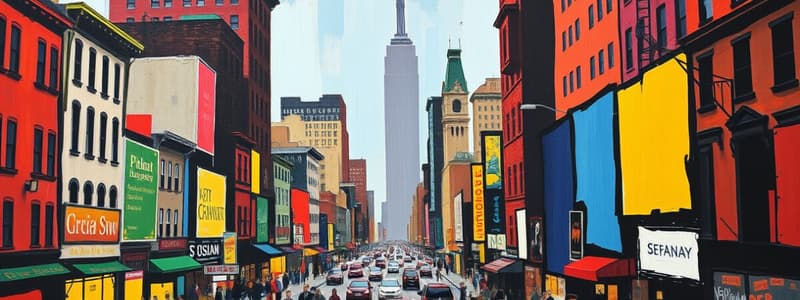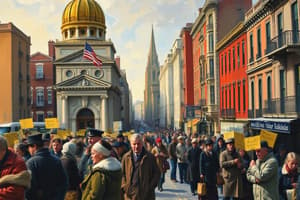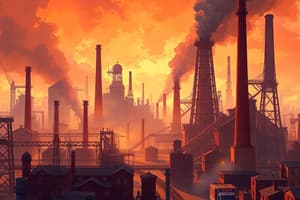Podcast
Questions and Answers
What key service standards were established across the United States by 1920?
What key service standards were established across the United States by 1920?
- Fire, police, and health departments (correct)
- Public transportation only
- Public sanitation only
- Educational institutions only
What was a significant outcome of New York's development of public transportation?
What was a significant outcome of New York's development of public transportation?
- Reduction in public school attendance
- Alleviation of congestion and pollution (correct)
- Increased social segregation
- Decreased urban population density
What factor sparked the Progressive Era movement regarding wildlife preservation?
What factor sparked the Progressive Era movement regarding wildlife preservation?
- A response to increased urbanization (correct)
- The destruction of urban landscapes
- Advancements in transportation technologies
- Economic growth of cities
How did urbanization affect green spaces in cities?
How did urbanization affect green spaces in cities?
What portion of Manhattan was preserved as Central Park during this urban development period?
What portion of Manhattan was preserved as Central Park during this urban development period?
What percentage of Americans lived in urban areas by 1900?
What percentage of Americans lived in urban areas by 1900?
Which historical phenomenon describes the movement of people from rural areas to cities in the United States?
Which historical phenomenon describes the movement of people from rural areas to cities in the United States?
Which two individuals are mentioned as examples of those who rose from humble beginnings during this urban growth?
Which two individuals are mentioned as examples of those who rose from humble beginnings during this urban growth?
What was the approximate U.S. population growth from 1860 to 1910?
What was the approximate U.S. population growth from 1860 to 1910?
Which of the following factors did NOT contribute to the urbanization of the United States?
Which of the following factors did NOT contribute to the urbanization of the United States?
What was one of the reasons people chose to move to cities during this time period?
What was one of the reasons people chose to move to cities during this time period?
In terms of population, which city was noted to have held more than two million people?
In terms of population, which city was noted to have held more than two million people?
What was a common perception of urban areas among immigrants arriving in the United States?
What was a common perception of urban areas among immigrants arriving in the United States?
What was a major health and safety issue in urban areas during the Gilded Age?
What was a major health and safety issue in urban areas during the Gilded Age?
How did housing conditions for urban dwellers often manifest during the Gilded Age?
How did housing conditions for urban dwellers often manifest during the Gilded Age?
What was Jacob Riis known for during the Gilded Age?
What was Jacob Riis known for during the Gilded Age?
What structural change was implemented in tenement buildings as a result of new housing laws?
What structural change was implemented in tenement buildings as a result of new housing laws?
What kind of segregation was prevalent among urban populations during the Gilded Age?
What kind of segregation was prevalent among urban populations during the Gilded Age?
What was a common issue with the sanitation of water during the Gilded Age?
What was a common issue with the sanitation of water during the Gilded Age?
What contributed to the rampant spread of diseases in urban areas during the Gilded Age?
What contributed to the rampant spread of diseases in urban areas during the Gilded Age?
What did the term 'dumbbell tenements' refer to?
What did the term 'dumbbell tenements' refer to?
Which of the following was a consequence of neglectful urban planning during the Gilded Age?
Which of the following was a consequence of neglectful urban planning during the Gilded Age?
What issue did the muckraker journalism reveal about urban living conditions?
What issue did the muckraker journalism reveal about urban living conditions?
Which of the following problems did rapid urbanization in the Gilded Age cause?
Which of the following problems did rapid urbanization in the Gilded Age cause?
What animal contributed significantly to sanitation problems in cities like New York during the Gilded Age?
What animal contributed significantly to sanitation problems in cities like New York during the Gilded Age?
What type of movements began to address the social problems of the Gilded Age?
What type of movements began to address the social problems of the Gilded Age?
Which aspect of urban life was not significantly improved until after the Gilded Age?
Which aspect of urban life was not significantly improved until after the Gilded Age?
Study Notes
Urbanization in America
- Pre-Civil War, only 17% of Americans lived in urban areas of 8,000 or more; by 1900, this rose to 40%.
- Major cities included New York (over 2 million), Chicago (over 1 million), and Philadelphia (also over 1 million).
- Population surge from 31 million in 1860 to 92 million in 1910 due to urbanization and immigration.
- Urbanization marked a shift from agrarian roots to an industrial economy, driven by manufacturing and labor influx.
- Over 25 million immigrants entered Northern American cities around the turn of the century, transforming demographics.
The Gilded Age
- The Gilded Age characterized urban life as a period of both allure and hardship.
- Cities offered cultural and recreational opportunities, including museums, theaters, and parks.
- Despite difficulties, urban areas represented the promise of the "American Dream," attracting young people aged 15-30 seeking better prospects.
Challenges of Urbanization
- Rapid population growth outpaced infrastructure development, leading to overcrowding and inadequate services.
- Poor health and safety standards worsened living conditions, with no organized waste management or fire services.
- In 1890, New York City faced severe sanitation issues, exemplified by the estimated 500,000 pounds of horse manure daily.
Housing Issues
- Overcrowded tenements housed families in unsafe conditions with inadequate facilities.
- Housing laws were ineffectively circumvented by landlords; many residents lived in "dumbbell tenements," designed for light but poorly ventilated.
- In 1895, New York was the world's most densely populated city, compounding issues of disease spread, including cholera and tuberculosis.
Muckrakers and Reform
- Investigative journalists like Jacob Riis exposed the harsh realities of urban life, raising awareness among the affluent.
- The Progressive Movement emerged, advocating for urban planning and improved living conditions, emphasizing public health and safety.
Urban Planning and Improvements
- Revisions to housing laws mandated better living conditions, including running water and fire safety measures.
- Improved sewage systems and sanitation became priorities to combat the spread of infectious diseases.
- By 1920, standardized services for fire, police, and health departments were established throughout cities.
Modern Urban Development
- New York pioneered public transportation innovations, easing road congestion and enhancing accessibility across neighborhoods.
- Conservation efforts during the Progressive Era led to the creation of parks, including Central Park, which set a precedent for urban green spaces.
Studying That Suits You
Use AI to generate personalized quizzes and flashcards to suit your learning preferences.
Description
Explore the rapid growth of urban areas in America from the eve of the Civil War to the turn of the 20th century. This quiz covers population shifts, major cities, and the factors driving urbanization during this transformative period in American history.




